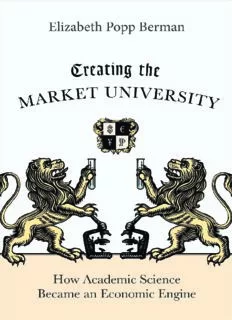
Creating the Market University: How Academic Science Became an Economic Engine PDF
Preview Creating the Market University: How Academic Science Became an Economic Engine
Creating the Market University Creating the Market University how academic science became an economic engine Elizabeth Popp Berman princeton university press princeton and oxford Copyright © 2012 by Princeton University Press Published by Princeton University Press, 41 William Street, Princeton, New Jersey 08540 In the United Kingdom: Princeton University Press, 6 Oxford Street, Woodstock, Oxfordshire OX20 1TW press.princeton.edu All Rights Reserved Library of Congress Cataloging-in-Publication Data Berman, Elizabeth Popp, 1975– Creating the market university : how academic science became an economic engine / Elizabeth Popp Berman. p. cm. Includes bibliographical references and index. ISBN 978-0-691-14708-6 (hardback) 1. Science—Study and teaching (Higher)—United States. 2. Universities and colleges— Research—Economic aspects—United States. 3. Academic-industrial collaboration— United States. I. Title. Q183.3.A1B466 2012 507.1'173–dc23 2011035707 British Library Cataloging-i n- Publication Data is available This book has been composed in Minion Pro Printed on acid- free paper. ∞ Printed in the United States of America 10 9 8 7 6 5 4 3 2 1 For my parents, with love Contents Acknowledgments ix Chapter 1 Academic Science as an Economic Engine 1 The Changing Nature of Academic Science 4 Studying the Changes in Academic Science 8 Explaining the Rise of Market Logic in Academic Science 12 Overview of the Book 17 Chapter 2 Market Logic in the Era of Pure Science 19 Federal Funding and the Support of Science Logic 21 Using Market Logic in the 1950s and 1960s 23 Limits to the Spread of Market Logic 29 The Pillars of the Postwar System Begin to Crumble 35 The Effects of the Dissolving Federal Consensus 37 Chapter 3 Innovation Drives the Economy— an Old Idea with New Implications 40 Market- Logic Practices of the 1970s and Their Limits 42 The Political Power of an Economic Idea 44 The Innovation Frame and the University 55 Chapter 4 Faculty Entrepreneurship in the Biosciences 58 Before Biotech 60 Early Entrepreneurship 63 1978: A Turning Point 69 Academic Entrepreneurship: Money Changes Everything 76 Why Did Bioscience Entrepreneurship Take Off? 87 Chapter 5 Patenting University Inventions 94 University Patenting during the Science- Logic Era 96 Barriers to the Expansion of University Patenting 104 Innovation, the Economy, and Government Patent Policy 106 University Patenting after 1980 111 Why Did University Patenting Take Off? 114 viii • Contents Chapter 6 Creating University- Industry Research Centers 119 UIRCs versus Biotech Entrepreneurship and University Patenting 119 The Trajectory of University- Industry Research Centers 122 The Emergence of Federal and State Support for UIRCs 131 The Expansion of State and Federal Support for UIRCs in the 1980s 139 Why Did University- Industry Research Centers Spread? 141 Chapter 7 The Spread of Market Logic 146 The Expansion of Biotech Entrepreneurship, Patenting, and UIRCs 147 Market Logic Elsewhere in Academic Science 149 University Administrators and the Rhetoric of Innovation 154 Science Logic and Market Logic: An Uneasy Coexistence 156 Chapter 8 Conclusion 158 How Academic Science Became an Economic Engine: Considering the Evidence 159 Reconsidering Alternative Arguments 162 Speaking to Larger Conversations 167 Notes 179 Bibliography 221 Index 261 Acknowledgments This book was a long time in the making, and I have incurred many debts along the way. Neil Fligstein has been a guiding influence since our first cap- puccino at Caffe Strada many years ago. He has always given me the freedom to find my own intellectual path, yet has probably shaped my thinking more than anyone else— maybe with the exception of Max Weber, which is not bad company to be in. Kim Voss was generous with her time and incisive with her questions as she listened to this project develop over the years. Todd LaPorte, who asked, “What is this a case of?” brought his insider’s knowledge of research administration at Berkeley as well as his academic expertise. Cathryn Carson taught me how to think like a historian, for which I am deeply grateful, although I still have an unhistorian- like tendency to look for patterns as well as narratives. And David Kirp provided a critical early opportunity to explore these issues when I worked on his book, Shakespeare, Einstein, and the Bottom Line: The Marketing of Higher Education. I owe enormous thanks to my dissertation group, LDG, for endless rounds of intellectual and moral support at Berkeley and beyond. Hwa- Jen Liu, Te- resa Sharpe, Lisa Stampnitzky, and Youyenn Teo, I would not have finished this book without you. Among the many people who made the Berkeley sociology department a lively and supportive place to be, I would particularly like to ac- knowledge Irene Bloemraad, Greggor Mattson, C. J. Pascoe, Jenn Sherman, and Jennifer Utrata. At Albany, I have had the good fortune to be part of a warm, collegial, and stimulating sociology department. I am particularly grateful for the support of Richard Lachmann and Jim Zetka, both of whom read the entire manuscript, and for helpful conversations with Ron Jacobs and Karyn Loscocco. My ju- nior colleagues (some no longer junior), Angie Chung, Kecia Johnson, Joanne Kaufman, Ryan King, Aaron Major, and Kate Strully, all gave helpful feedback on chapters as well as making the department a fun place to be. I am also deeply appreciative of research assistance from Rakkoo Chung, Josh McCabe, Laura Milanes, Nick Pagnucco, and Myeongjae Yeo. A larger intellectual community has also shaped this project. Martin Kenney, Daniel Kleinman, Mike Lounsbury, Jason Owen- Smith, and an anonymous re- viewer read the whole manuscript and provided trenchant suggestions that I hope made this a better book. Lauren Edelman, Rita Gaber, Elihu Gerson, Ed Hackett, Chris Niedt, Martha Poon, Sergio Sismondo, and Doogab Yi all pro- vided useful and much- appreciated feedback on shorter sections. Conversa-
Description: